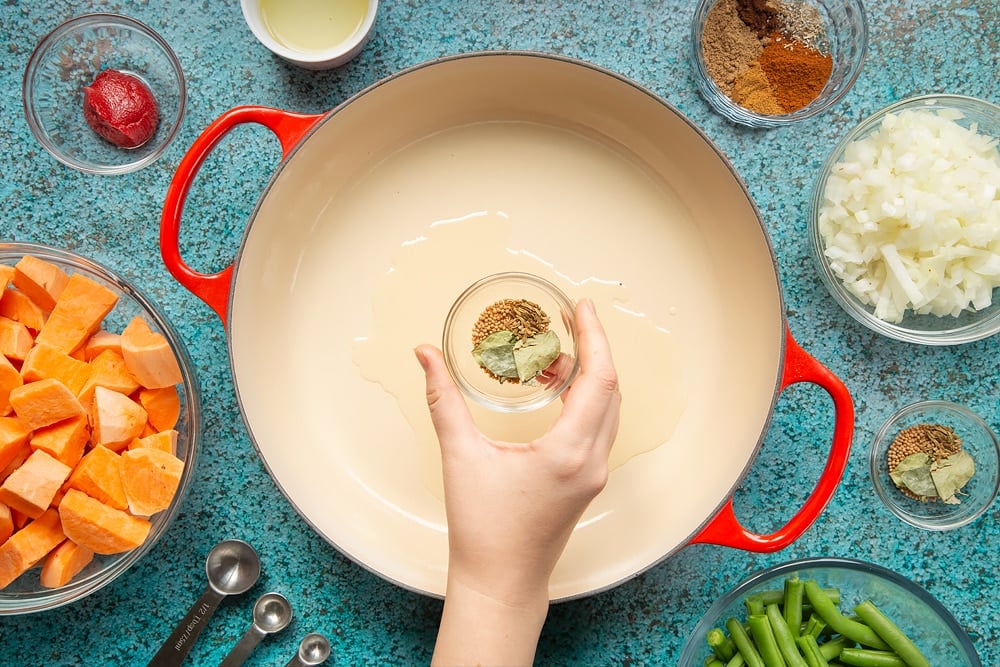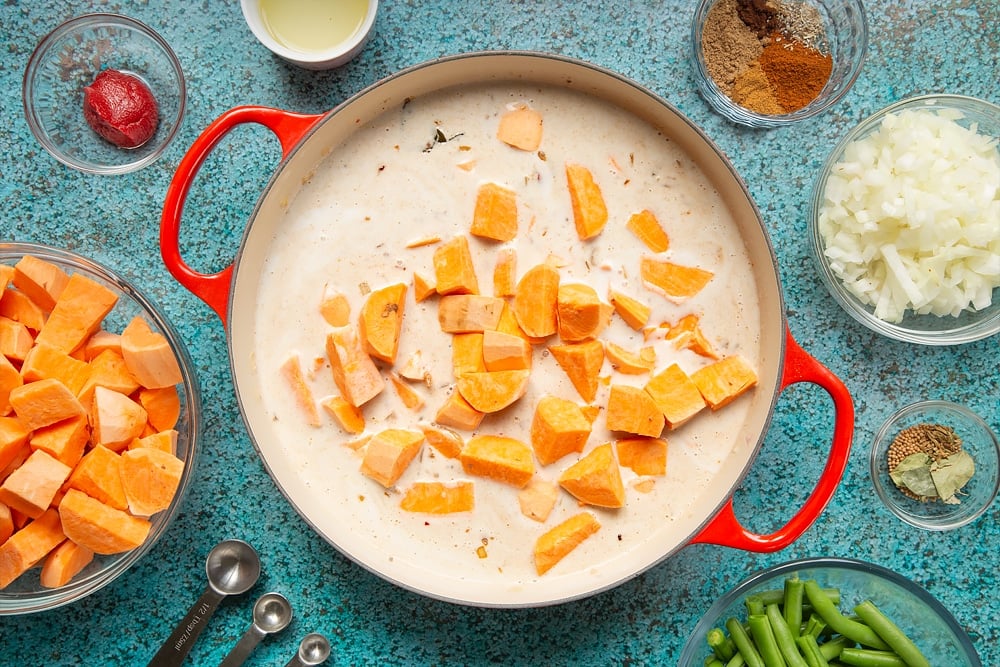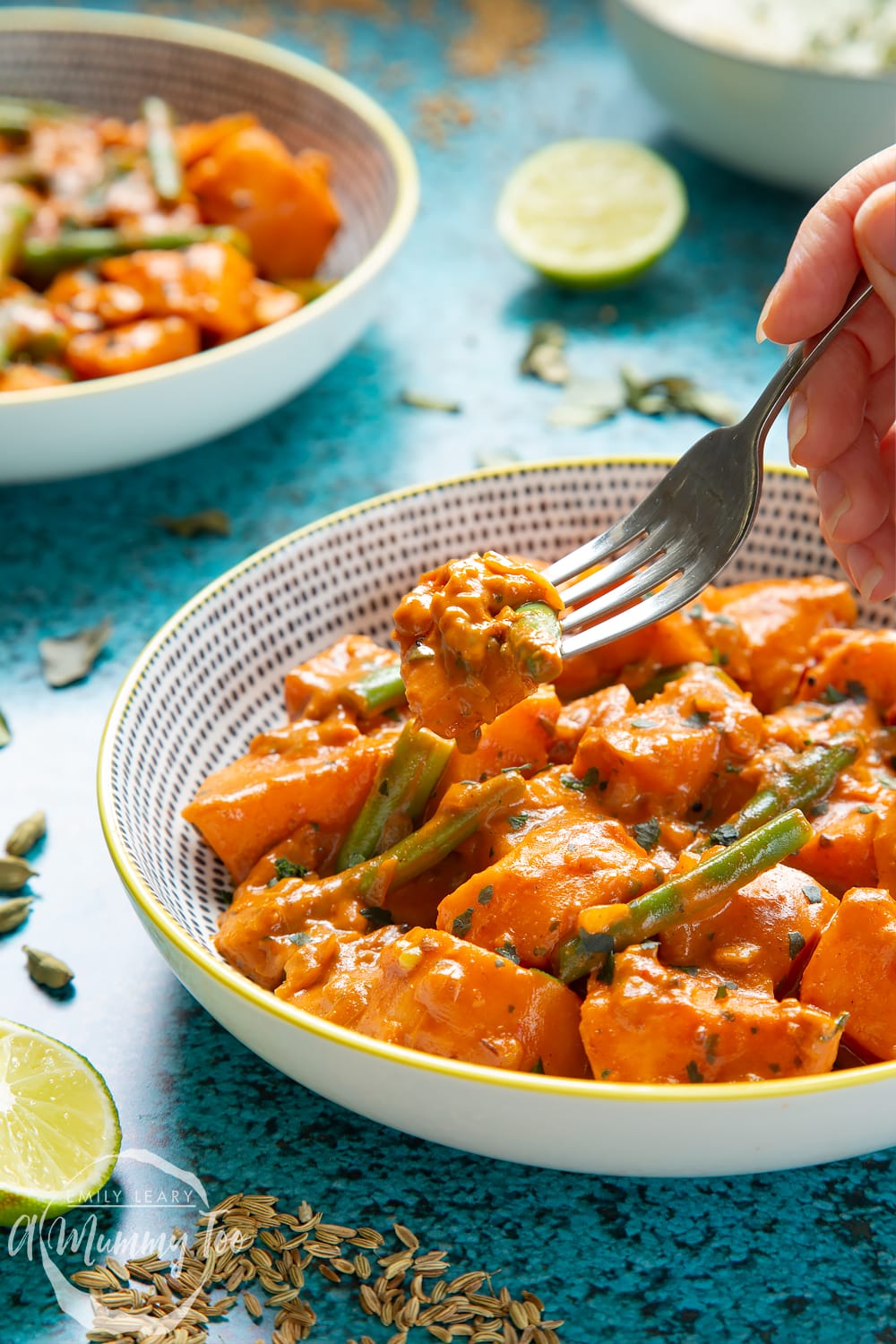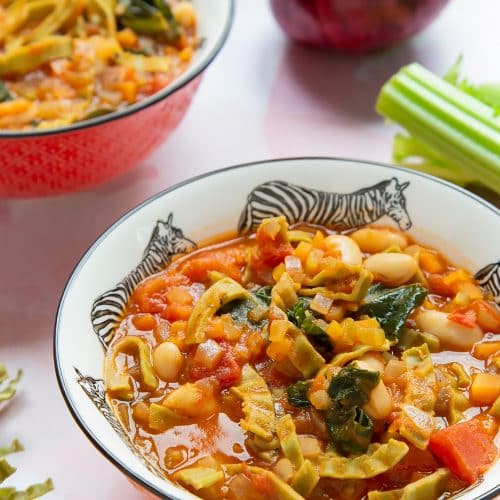This fantastically smooth vegan Sri Lankan curry has a beautifully rich and deep flavour thanks to garlic, ginger, chilli, curry spices and cloves, all mellowed out with creamy coconut milk and earthy sweet potatoes.

Sri Lankan cuisine is wonderfully unique thanks to a strong history of spice production and trade. You can see hints of everything from India and Indonesia to Dutch cuisine in many of its dishes.
This vegan Sri Lankan curry is also so a great example of 'tempering' spices; heating them in oil to bring out their flavour - so take your time to appreciate the wonderful aromas they give off and how it elevates the taste of the ingredients.

I like to serve this silky smooth curry with rice, pickled fruits and vegetables, chutney or sambol (a type of spicy chilli sauce or paste).
For this recipe, you'll make a Sri Lankan curry blend using dried spices (don't worry, there's nothing too unusual!) and you'll also use chopped chilli, garlic, ginger and coriander to round the flavour out.
For added convenience, I've used frozen herbs for the chilli, garlic, ginger and coriander in this dish.

The frozen ones can be found in pretty much every supermarket these days, and they come pre-chopped in cartons or sachets, so you can sprinkle in just what you need and pop the rest back in the freezer. So clever!
Here's what to do to enjoy this amazing, aromatic curry.
Ingredients
- 2 tbsp vegetable oil (canola oil)
- 1 tsp mustard seeds
- ¼ tsp fennel seeds
- 5 curry leaves
- 1 onion peeled and finely chopped
- 1 tbsp chilli chopped
- 1 tbsp garlic chopped
- 1 tbsp fresh root ginger chopped
- 1 tbsp ground coriander
- ½ tbsp ground cumin
- 1 tsp cayenne pepper
- 5 cardamom pods crushed
- ¼ tsp ground cloves
- 3 tbsp tomato puree
- 800 g (17 oz) canned coconut milk
- 800 g (2 lb) sweet potatoes peeled and diced
- 200 g (7 oz) green beans halved
- 1 tbsp fresh coriander (cilantro) chopped
- 1 pinch salt and black pepper to taste
Instructions
Heat the oil over a medium heat.

Add the mustard seeds, fennel seeds and curry leaves.

Fry for 2 minutes until fragrant. The mustard seeds may pop like popcorn, so it's safest to pop a lid on and shake the pan as they fry.

Add the onion, chilli, garlic and ginger.

Fry for another 3-5 minutes until the aromas are released - take care not to burn.

Add the coriander, cumin, cayenne, cardamom, and cloves.

Fry for a further 2 minutes, stirring to prevent burning.

Add the tomato puree and coconut milk

Stir.

Add the sweet potato.

Stir.

Bring to the boil, then reduce to a simmer and cook for 10 minutes, stirring occasionally.

Add the green beans.

Cook for a further 5 minutes.

Stir in the coriander, season to taste and serve.

Tempting, right?

More about frozen herbs
I'm becoming quite a fan of frozen herbs for their versatility and easy storage.
You might think, who needs frozen when they're so easy to buy fresh? But with a busy lifestyle or trips away, I'm sure everyone can relate to the scenario of buying herbs, using half a pack only for the other half to wilt and turn bad in the fridge.
And as much as I love growing our own herbs, we're all let the odd supermarket herb pot meet a rather sad, wilted end on the windowsill, right?
That's why I've been finding frozen herbs so useful - tons of flavour, easy to use, easy to store for months on end, no waste and none of the upkeep of fresh herbs.
I've also discovered that frozen herbs and spices are made from 100% leaf/flesh, no stalks or skin to chuck away, so weight for weight, frozen versus fresh is actually very economical.
If you do pick up frozen fresh herbs for use in your cooking, chances are they'll be supplied to your supermarket of choice by Daregal.
In the UK, they tend to hit the shelves in supermarket own-brand packaging, so while you've probably never heard of Daregal, they're practically herb royalty.
Started in France in 1887, Daregal's continued passion, expertise and knowledge means it now supplies top-quality frozen herbs around the world, which in the UK include Iceland, Sainsbury's, Tesco, Asda and M&S.
I reckon any company that's over 130 years old and has a client list like that has to be doing something right., right?

As with some vegetables, such as peas, it seems that fresh produce that is harvested and then almost immediately frozen to lock in their essential oils can often hit your pan with even more flavour and freshness than if you had bought something "fresh".
That's because fresh but not frozen herbs may have been picked several days ago and stored in your fridge for the same amount of time - making for something wilted and without as much flavour by the time you get round to cooking.
Once you start to realise that you have access to a bunch (haha!) of fresh herbs literally anytime you want them, it will also start to open up nightly cooking choices without the need to run to the shops as you'll find you often have all the dry and fresh ingredients already in your kitchen.

A carne asada marinade with plenty of fresh coriander? Easy. A super quick arrabiata with a little olive oil, a few cans of tomatoes, a little fresh garlic and fresh chilli? Done. A fresh ginger, honey and lemon tea to relax after a hard day cooking? Yes, please.
I'm not saying there's no place in the kitchen for fresh, but I'm sure you can see why I'm a big frozen fan!
Pointers, tricks and troubleshooting tips for the perfect Sri Lankan curry
Is vegan Sri Lankan curry easy to make?
This vegan Sri Lankan curry looks impressive but is actually rather easy to make and you'll only need one pot!
Just be careful when you are tempering your spices so as not to burn them and be aware that the seeds may pop in the hot oil so stand back or use a lid!
Will I need any special equipment for this recipe?
The great thing about this recipe is that it requires very little equipment and nothing that you shouldn't find in almost any kitchen.
And one-pot meals are always a winner!

How can I tell if my dried spices are old or have lost their flavour?
Whether they are whole seeds or ground, dried spices generally last many years, although they will lose their essential oils and thus their flavour as time goes by.
If your spices don't smell particularly strong or are a long time past their 'best before' date it may be better to replace them.
Heat and sunlight will make spices lose their flavour faster so keep them out of direct sunlight and somewhere cool and dry.
If at all possible, it's well worth investing in some spice racks so that you can organise your spices and see them all when you open the cupboard. This will help you use up what you have instead of accidentally ended up with three half-used bottles of cumin powder!
Is Sri Lankan curry suitable for vegetarians? Is this recipe suitable for vegans?
This recipe is completely free of animal products, so it is suitable for both vegetarians and vegans.
Is vegan Sri Lankan curry gluten-free?
Yes, this curry is totally gluten-free as there are no ingredients containing gluten.
However, it is important to be careful to check the packaging of each individual ingredient for gluten or warnings about being produced in a factory where cross-contamination could occur.
Always check with your healthy professional if you are unsure.
Is Sri Lankan curry keto-friendly?
As this dish contains sweet potatoes, it would be considered too high in carbohydrate to be keto-friendly.
However, as that's where the majority of the carbs are coming from, you may be able to replace them with something like cauliflower to get something closer to a keto-friendly dish.
Is Sri Lankan curry healthy?
This dish is packed with vegetables, so it nutritionally rich. However, it is quite high in fat thanks to the coconut milk.
If you're looking to reduce the fat content, you could try using reduced-fat coconut milk.
What goes well with Sri Lankan curry?
I like to serve this vegan Sri Lankan curry with rice with a little fresh coriander stirred through. I also love serving this curry with pickled fruits and vegetables, chutney or sambol (a type of spicy chilli sauce or paste).
Can I make vegan Sri Lankan curry without some of the herbs and spices?
The delicate balance of different herbs and spices is what makes this dish particularly good, so do use them all if you can.
However, if you don't have one or two of the ingredients you can probably get away with just not including it and still end up with something delicious.
I haven’t got fresh herbs can I use frozen? Can I use dried herbs and spices?
If you don't have fresh herbs, garlic, chilli or ginger then frozen is absolutely great, perhaps even preferable, and something I do often.
You could potentially also use dried ginger or chilli etc, but you will probably get a different taste and you'll need to reduce the quantities since dried has a different volume and weight.

Can I add extra spice to vegan Sri Lankan curry?
While the ratio of spices I've used here is perfect for me, you can, of course, add more or less of anything you fancy if you would like something to have more of a pronounced flavour - just don't go overboard!
This curry is already quite spicy but if you prefer a hotter curry then you can add more than 1 tsp of cayenne pepper and/or 1 tbsp of fresh chilli than listed in the ingredients.
You can also, of course, reduce these ingredients if you prefer something milder, but I wouldn't recommend cutting them both out entirely as spices are included for flavour as well as heat.
How should I store this vegan Sri Lankan curry? Can I keep this recipe in the refrigerator?
Cool the curry to room temperature within 2 hours of cooking, store in an airtight container and place in the fridge where it should last for up to 3 days.

Can I freeze vegan Sri Lankan curry?
As with keeping in the fridge, to freeze your curry, you should first cool it down to room temperature within 2 hours of cooking, then place in an airtight container in the freezer where it will keep for up to 3 months.
How long does vegan Sri Lankan curry keep?
If properly stored, your curry should last up to 3 days in the fridge, or up to 3 months in the freezer.
Can I leave vegan Sri Lankan curry out on the counter?
No. Always place curry in the fridge or freezer within two hours after cooling and discard it if it has been left out at ambient temperature for longer.
What is the best way to reheat vegan Sri Lankan curry?
To reheat this recipe, simply add the desired amount of cooled curry to a saucepan and place over a low-medium heat. Make sure the sweet potato is hot all the way through before serving, and add a little water to the saucepan if you find it has thickened up too much.
You can also place the cooled curry in a microwave-safe bowl and microwave it on medium until piping hot through.
You will likely find that once reheated the sweet potatoes will become rather soft. While this will impact the texture a little, but it'll still be a delicious dish.
If you’re reheating from frozen it's best to get the curry out of the freezer the night before and allow it to defrost in the fridge overnight.
Going directly from freezer to microwave should be fine as long as you give it a stir a few times during cooking, although you may find it breaks down more using this method.

Can I make this vegan Sri Lankan curry recipe in a different quantity?
Yes, this is the type of dish that scales up or down really easily, whether it's for a big family gathering or a meal for two.
Simply use the slider in the recipe card below to adjust the quantities as needed.
Why did my curry turn out so wet?
Make sure that you get the quantities correct, as this curry really shouldn't be too wet if you have followed the instructions.
Also, make sure that you have cooked everything for the correct amount of time as this will help to reduce the sauce while the sweet potatoes soak up some of the water.

How can I add/change the flavours in this dish?
Once you have tempered the spices, it's up to you exactly what veg you use. Anything from cauliflower to carrots would work well - be brave!
Print this vegan Sri Lankan curry recipe
If you’d like to make this flavourful curry for yourself here’s the recipe again in an easily printable format.
Vegan Sri Lankan Curry Recipe
Ingredients
- 2 tbsp vegetable oil (canola oil)
- 1 tsp mustard seeds
- ¼ tsp fennel seeds
- 5 curry leaves
- 1 onion peeled and finely chopped
- 1 tbsp chilli chopped
- 1 tbsp garlic chopped
- 1 tbsp fresh root ginger chopped
- 1 tbsp ground coriander
- ½ tbsp ground cumin
- 1 tsp cayenne pepper
- 5 cardamom pods crushed
- ¼ tsp ground cloves
- 3 tbsp tomato puree
- 800 g (17 oz) canned coconut milk
- 800 g (2 lb) sweet potatoes peeled and diced
- 200 g (7 oz) green beans halved
- 1 tbsp fresh coriander (cilantro) chopped
- 1 pinch salt and black pepper to taste
Instructions
- Heat the oil over a medium heat.
- Add the mustard seeds, fennel seeds and curry leaves. Fry for 2 minutes until fragrant. The mustard seeds may pop like popcorn, so it’s safest to pop a lid of a shake the pan as they fry.
- Add the onion, chilli, garlic and ginger. Fry for another 3-5 minutes until the aromas are released – take care not to burn.
- Add the coriander, cumin, cayenne, cardamom, and cloves. Fry for a further 2 minutes, stirring to prevent burning.
- Add the tomato puree and coconut milk. Stir.
- Add the sweet potato. Stir.
- Bring to the boil, then reduce to a simmer and cook for 10 minutes, stirring occasionally.
- Add the green beans. Cook for a further 5 minutes.
- Stir in the coriander, season to taste and serve.
Video
Notes
Nutrition
Pin this vegan Sri Lankan curry

More vegan dinner recipes to try
Have you got my book?

'This is a great kids cookery book. Emily is a star' - Simon Rimmer
'The book I'd like to force into any mother's kitchen' - Prue Leith
"A fab book with a plan." - Jane Devonshire, 2016 Masterchef UK winner
'Emily has managed to combine her mummy knowledge and passion for food to make a truly helpful and brilliant cookbook' - Priya Tew, RD, BSc (Hons), Msc
Get Your Kids to Eat Anything is an achievable 'how to' for parents in the battle to overcome picky eating and 'make new the norm'. Emily Leary's unique 5-phase programme looks at the issue of 'fussy eating' in a holistic way that links imagination with food, and which situates parents alongside - not in opposition to - their children.






Rachel says
You mention adding fenugreek in the method but it’s not listed in the ingredients.
Emily Leary says
Thanks for letting me know. I've corrected that. If you would like to use fenugreek, you can include 1/2-1 tsp.
Ursula says
Fragrant, delicious and vegan- this recipe was a winner!
Emily Leary says
I'm so glad!
mohan kumar says
This sounds gorgeous.I’m actually considering making this.
Emily Leary says
I'm so pleased! Let me know how you get on.